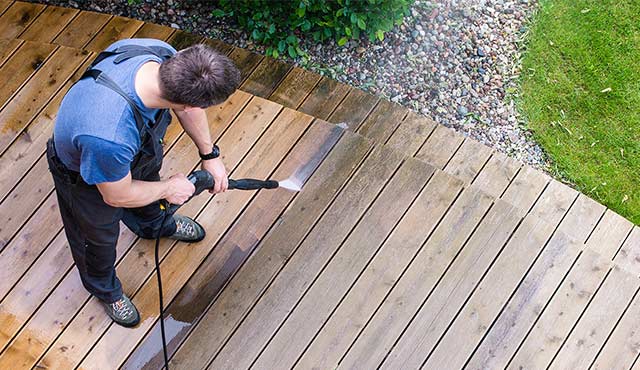A Comprehensive Overview to Various Kinds of Deck Staining Techniques for Ultimate Protection and Appearances
In the world of deck upkeep, the art of discoloring stands as an essential step in the direction of both preserving the integrity of your outdoor area and improving its aesthetic allure. As we navigate with the intricate world of deck staining techniques, one starts to appreciate the nuanced methods that can make all the difference in between a sub-par coating and a perfect one.
Recognizing Different Types of Spots
Different types of spots are frequently used in the process of deck staining to achieve different visual and protective effects. On the other hand, semi-transparent spots supply a balance between color enhancement and defense, permitting some timber grain to show through.
Moreover, there are additionally specialized discolorations such as sealers and toners. Toners include a hint of color to the timber while giving very little security, making them ideal for newer decks with less wear. Sealers, on the other hand, offer security versus moisture and UV rays without adding shade, making them a preferred option for decks that currently flaunt a desirable color. Recognizing the qualities and benefits of each kind of tarnish is crucial for achieving the desired appearance and toughness for your deck.
Choosing the Right Discoloration Shade
When considering the aesthetics of your deck discoloration task, the choice of stain color plays an important duty in enhancing the safety high qualities of the selected tarnish kind (Stain Deck). The color you select can dramatically impact the total look of your deck, in addition to its capacity to withstand the components with time
When picking a discolor color, it's necessary to consider the existing color pattern of your home's exterior. Integrating the deck tarnish with the total aesthetic of your property can create a visually appealing and cohesive outdoor area. Furthermore, the shade of your deck tarnish can influence the temperature level of the deck surface area; darker shades tend to take in even more warmth, while lighter colors reflect sunlight and remain cooler.
Furthermore, the sort of timber you are discoloring will likewise influence exactly how the discolor color appears. Different timber types can engage with the tarnish in various means, potentially changing the final color. It's a good idea to test the tarnish on a little, low-profile area of the deck to guarantee the shade transforms out as preferred before continuing with the whole job.
Preparing Your Deck for Staining
To guarantee a resilient and effective deck discoloration task, comprehensive preparation of the deck surface area is vital. Begin by cleaning up the deck extensively to get rid of dirt, grime, mold, and any kind of old stain or complete.
Examine the deck for any type of harmed or rotten boards that require to be changed. Hammer down any kind of extending nails and sand any kind of rough locations to guarantee a smooth surface for staining. Check for any loosened railings or steps that may require tightening or repair work.
Once the deck is clean, completely dry, and in excellent repair work, think about applying a timber brightener to restore the deck's natural shade and open the wood pores for better tarnish penetration. Safeguard any kind of neighboring plants, furnishings, or surfaces with plastic sheeting prior to proceeding with the discoloration process. Appropriate preparation is essential to accomplishing a professional-looking finish and making best use of the long life of your deck stain.
Applying Spot With Different Strategies
For a perfect and professional surface, the method of using tarnish plays an important duty in enhancing the appearance and toughness of your deck. There are a number of methods you can utilize to make sure an effective application of tarnish.
Cleaning is a standard method that permits precision and control over the quantity of stain applied. It is excellent for elaborate locations and reaching in between deck boards (Water-Based Stains). Rolling is a quicker choice, covering larger surface areas efficiently. Back-brushing after rolling is recommended to even out the stain and work a knockout post it into the wood for much better infiltration.
Splashing is another popular method, offering rate and convenience of application, particularly for huge deck areas. It is crucial to make use of a top quality sprayer and be conscious of overspray. Pad applicators offer a smooth and even end up and are suitable for both horizontal and upright surfaces. Whichever method you pick, making certain proper preparation and adhering to maker guidelines will certainly aid accomplish a stunning and lasting tarnish surface on your deck.

Maintaining and Re-staining Your Deck
When it comes to re-staining your deck, the regularity depends on various aspects such as the kind of tarnish used, the climate in your location, and exactly how much wear and tear your deck experiences. Typically, it is suggested to re-stain your deck every 2-4 years to maintain its defense and visual appeals.
Before re-staining, ensure the deck is clean, dry, and free of any type of previous tarnish deposit. Sanding might be necessary to ravel harsh areas or remove old stain that is flaking. Select a premium tarnish that matches your deck's product and provides the desired level of defense. Use the discolor equally using the ideal strategy gone over earlier in this overview to guarantee a long-lasting and stunning Discover More Here coating - Chicago Deck Staining. By staying aggressive with upkeep and re-staining, you can enjoy a aesthetically attractive and well-protected deck for several years ahead.
Final Thought
To conclude, recognizing the different sorts of deck stains, picking the ideal shade, effectively preparing the deck, using stain with numerous techniques, and preserving and re-staining the deck are necessary actions for ultimate defense and visual appeals. By complying with these actions, you can make sure that your deck continues to be in leading problem for many years to find.
Additionally, the shade of your deck discolor can influence the temperature level of the deck surface area; darker shades have a tendency to absorb more heat, while lighter colors mirror sunshine and remain cooler.
It's recommended to test the tarnish on a small, unnoticeable location of the deck to guarantee the color turns out as wanted prior to continuing with the whole project.
